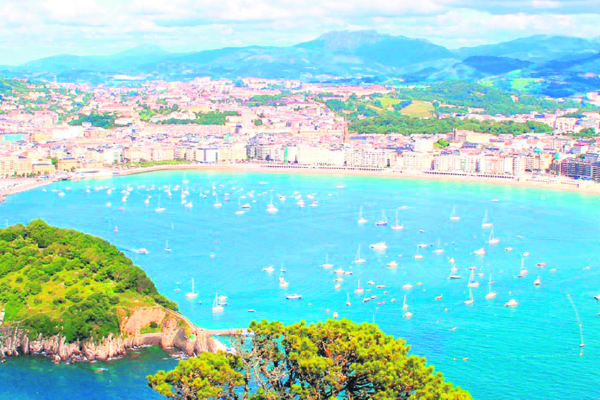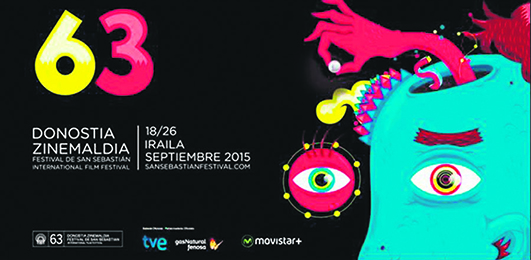
San Sebastián
It’s said that nothing is impossible. This is wrong. It’s impossible to lay eyes on San Sebastián (Basque: Donostia) and not fall madly in love. This stunning city is cool, svelte and flirtatious by night, charming and well mannered by day. It’s a city that loves to indulge, and with Michelin stars apparently falling from the heavens onto its resturants and a pintxo (tapas) culture almost unmatched anywhere else in Spain, San Sebastián frequently tops lists of the world’s best places to eat. But just as good as the food is the summer fun in the sun.
For its setting, form and attitude, Playa de la Concha is the equal of any city beach in Europe. Then there’s Playa de Gros (also known as Playa de la Zurriola), with its surfers and sultry beach-goers. As the sun falls on another sweltering summer’s day, you’ll sit back with a drink and an artistic pintxo and realise that, yes, you too are in love with San Sebastián.
San Sebastián has four main centres of action. The lively Parte Vieja (old town) lies across the neck of Monte Urgull, the bay’s eastern headland, and is where the most popular pintxo bars and many of the cheap lodgings are to be found.
South of the Parte Vieja is the commercial and shopping district, the Centro Romántico, its handsome grid of late-19th-century buildings extending from behind Playa de la Concha to the banks of Río Urumea. On the east side of the river is the district of Gros, a pleasant enclave that, with its relaxed ambience and the surfing beach of Playa de Gros, makes a cheerful alternative to the honeypots on the west side of the river. Right at the opposite, western end, of the city is Playa de Ondarreta (essentially a continuation of Playa de la Concha), a very upmarket district known as a millionaires’ belt on account of its lavish holiday homes.
Read more: http://www.lonelyplanet.com/spain
Beach
There are two main beaches, one on either side of the river.
La Concha, on the west side is the larger, is protected from the sea and has an island and boats in the bay. Ondarreta is in the same bay as La Concha, but split by El pico del Loro (a rocky outcropping). La Concha and Ondarreta has umbrellas, tents and lounge chairs for €15 per day; free WC, showers and changing rooms. A team of fully-equipped life-guards are there during the daytime.
La Zurriola to the east of the old town and river is a surf beach, clearly better if you want waves or beach sports.
Surfing – surfboards and bodyboards can be rented on Zurriola beach. You’ll probably want to spring for a wetsuit as well. The surf shop also offers surf lessons (around €65 per person for five one-hour lessons in a small group) [20].
Hiking
For a short easy hike visit the statue of Christ on top of the mountain between the beaches. It takes around an hour to walk up at a leisurely pace. There’s a bar on the way up if you need to stop for refreshments or admire the view. To reach the bar: find a library; from there find directions upstairs to a Castle; follow the stairs along green hedge. The park officially closes at 9pm in summer (in reality, gates close bit later), and the bar closes before sunset in summer time–and definitely before park is closed.
For a longer hike, head up the hill from Zurriola by taking Zemoria St up from the east end of the Zurriola, and following the long stairway at the end of Zemoria St up to the hiking path which is toward the left. From there, follow the trail marked by the red & white markings to Pasaia/San Pedro. Initially, the trail is marked by red, white, and green stripes, but the green trail diverts halfway in. The full hike from San Sebastian to Pasaia/San Pedro is approximately 5.5 miles one-way and should take around 2.5 hours.
Tennis and squash: There is a single tennis court (roofed), and two open-air squash courts–both between the El pico del Loro beach and bottom of Mount Igeldo.
Tourist Land Train – a tourist land train leaves from the Calle Zubieta in front of La Concha Beach.
Aquarium – by the Paseo de Kaiko, at the far right of La Concha Beach [21].
Kayak – kayaks can be hired on Ondarreta beach, for about €7 per hour.
Water skiing in the La Concha bay
Amusement Park – an aging amusement park with quaint rides can be found at the top of Mount Igeldo, at the West end of La Concha bay. A funicular (cable-car) will take you up and down the mountain (approx €1.40 each way; operates 10am-9pm). If you use your own transport to get up (including walking) you’ll have to pay a €2.20 per person toll at the top. As well as the rides, the top of the mountain provides a great view of the town.
http://wikitravel.org/
San Sebastían Hotels Most Expensive in Spain
According to a recent survey carried out by online hotel comparison website, Trivago, among the 2 million or more daily visitors to the site, the cheapest cities for hotel stays, at European level, are Warsaw, with an average price of 62 euros per night in June, representing an increase of 2% over the same month of last year, followed closely by Bucharest, with an average price of 70 euros per night (+4%).
The most expensive cities, according to the survey, are Geneva, with an average price of 284 euros (+23% over June 2014), followed by London (263 euros, +11%) and Venice (250 euros, +17%).
Hotel stays in Lisbon registered an average price of 114 euros per night, representing a rise of 11% over the previous year, while the Greek capital, Athens, recorded the greatest increase in the average price per night, of 51%, to reach 143 euros.
In Spain the average price of hotels stood at 118 euros per night, compared with 107 euros in the same month a year earlier, representing an increase of 10% per night, with the cheapest cities being Lleida (58 euros), and Murcia and Zaragoza (both with 60 euros on average).
The report indicated that the average price per night in a standard double room remained stable in San Sebastían – the most expensive city according to the survey – at 189 euros, and also in Pamplona (143 euros), while prices increased by 33% in Cáceres, to 88 euros, followed by Santa Cruz (+27%) and Toledo (+22%), both with an average cost of 82 euros.
Moreover, prices in Madrid increased by 21% to an average of 99 euros; in Valencia they rose by 19% to 89 euros; and in Murcia – one of the cheapest cities in which to stay – prices also increased by 19%, reaching an average price of 60 euros per night.
El Economista reported that also among the most expensive cities in Spain stood Palma, with an average price of 164 euros (+6%), followed by Barcelona (160 euros, +15%), and Cadiz, with an average price of 144 euros, while in contrast, the average prices for hotel stays in Badajoz, Tarragona and Segovia fell by 10%, 9% and 8%, respectively, over the same month of the previous year.
keyero.com










